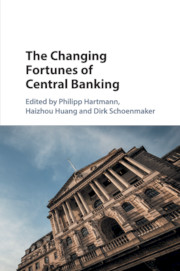Book contents
- The Changing Fortunes of Central Banking
- The Changing Fortunes of Central Banking
- Copyright page
- Contents
- Figures
- Tables
- Contributors
- Acknowledgement
- 1 Introduction and Overview
- Part I Monetary Economics and Policy
- Part II Financial Stability and Regulatory Policy
- 8 The Macroprudential Toolkit
- 9 Three Cooks or Three Wise Men?
- 10 Liquidity, Default and the Interaction of Financial Stability and Monetary Policy
- 11 Systemic Risk Measurement and Quantification of Systemic Risk Amplification
- 12 What Binds? Interactions between Bank Capital and Liquidity Regulations
- 13 Is Burden Sharing Needed for International Financial Stability?
- Part III Foreign Exchanges and International Architecture
- Part IV The Millennium Challenges of Central Banks
- Index
- References
9 - Three Cooks or Three Wise Men?
The Interplay between Monetary, Macroprudential and Microprudential Policies in Supporting Financial Stability
from Part II - Financial Stability and Regulatory Policy
Published online by Cambridge University Press: 29 March 2018
- The Changing Fortunes of Central Banking
- The Changing Fortunes of Central Banking
- Copyright page
- Contents
- Figures
- Tables
- Contributors
- Acknowledgement
- 1 Introduction and Overview
- Part I Monetary Economics and Policy
- Part II Financial Stability and Regulatory Policy
- 8 The Macroprudential Toolkit
- 9 Three Cooks or Three Wise Men?
- 10 Liquidity, Default and the Interaction of Financial Stability and Monetary Policy
- 11 Systemic Risk Measurement and Quantification of Systemic Risk Amplification
- 12 What Binds? Interactions between Bank Capital and Liquidity Regulations
- 13 Is Burden Sharing Needed for International Financial Stability?
- Part III Foreign Exchanges and International Architecture
- Part IV The Millennium Challenges of Central Banks
- Index
- References
Summary
- Type
- Chapter
- Information
- The Changing Fortunes of Central Banking , pp. 135 - 152Publisher: Cambridge University PressPrint publication year: 2018

